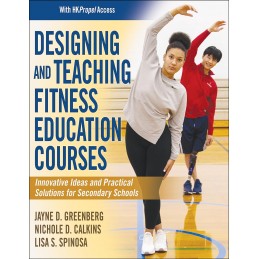Fitness education is often overlooked for various reasons:: no equipment, no weight room, large class size, or lack of professional development.
Designing and Teaching Fitness Education Courses provides real solutions for all these issues. This book offers secondary-level physical educators innovative ideas, practical answers, and guidance in implementing fitness education programming that will meet the needs of all students.
Designing and Teaching Fitness Education Courses is packed with highly useful tools and resources::
- 211 instructional photos showing exercises and stretches that require no equipment and are easily adapted for varying abilities
- 18 pacing guides that form a week-by-week blueprint for implementing a semester-long fitness education course
- A robust online resource with
- all 18 pacing guides, as well as a blank template for developing your own;
- 139 video demonstrations of all the books exercises and stretches;
- PowerPoint presentations to show in PE classes, including video demonstrations of the books exercises and stretches; and
- teacher aids and student handouts, including assignments, assessments, posters, and a 12-week personal fitness plan
Teachers can use the pacing guides to develop a semester-long fitness education course that can be implemented in either a traditional or block schedule. These guides offer objectives, class discussion topics, activities, assessments, and teaching strategies for each week of an 18-week semester. All topics in the guides are aligned with SHAPE Americas National Standards and Grade-Level Outcomes for K-12 Physical Education.
The authors guide teachers in addressing the following priorities within a fitness education course:: social and emotional learning; behavior modification principles and adherence to fitness activities; social cognitive theory; classroom management; student safety; equity, diversity, and inclusion; and social justice.
Designing and Teaching Fitness Education Courses also includes a detailed chapter on nutrition education written by internationally recognized sport nutritionist Lisa Dorfman, who provides teachers a wealth of information to integrate into fitness courses.
Teachers will learn how to integrate a quality fitness education curriculum into any setting (rural, urban, or suburban) and any learning model (remote, hybrid, or in-person learning).
Designing and Teaching Fitness Education Courses is organized into three sections::
- Part I presents both theoretical and practical knowledge of fitness education; its importance in a standards-based curriculum; pedagogical and content knowledge considerations; nutrition, wellness, and consumer issues; and the general components of fitness education.
- Part II focuses on various components of fitness education:: flexibility, strength, and cardiorespiratory fitness. This part includes stretching and muscular strength and endurance workouts, illustrated with photos in the book and videos in the online resource.
- Part III guides readers in enabling students to participate in community fitness and activity events to support the development of lifelong fitness habits.
Through
Designing and Teaching Fitness Education Courses, teachers will be able to provide appropriate fitness activities that will lead to the elevated health and wellness of students and a greater appreciation for participating in lifelong activities.
Note:: A code for accessing HK
Propel is included with all new print books.


 Dostawa
Dostawa
 Płatność
Płatność
 Zwroty
Zwroty
